The Windows 10 Review: The Old & New Face of Windows
by Brett Howse on August 25, 2015 8:00 AM EST- Posted in
- Operating Systems
- Microsoft
- Windows 10
The Windows Store: Unifying Across Devices
The original iPhone had no App Store. It seems hard to believe now since the App Store is one of the biggest strengths of iOS and has been for some time. It’s a model that has been successful and one that is now a staple of all platforms. Windows 8 introduced the Windows Store to Microsoft’s desktop platform, but it never really saw the success that was necessary to elevate it and the tablet apps to the level needed to drive sales.
Microsoft has made some pretty big changes to the store for Windows 10, and more are on the way. Likely the biggest change, and this one is not yet 100% realized, is that Microsoft, with Windows 10, is unifying their platform across all device types. This allows them to provide a single store which can have apps which can be run on everything from IoT to desktop to phone, and eventually Xbox One in November, and the Microsoft Hololens when it launches sometime in the next year.
So what does it mean to unify the platform? This is not about providing phone apps for use on the tablet, or tablet apps which don’t really work well on a phone. By providing a common set of APIs across all of their platforms, the developer can now write a single app which can be used on any device they want. Rather than stretch out a phone app to run on a desktop, the platform is designed to allow scaling of apps across all devices. The developer will have to provide a bit of work to make the UI work on different devices, but the amount of work required is a lot less. Another big part of the system is that apps will be designed with XAML layouts, which can be automatically scaled by the operating system depending on a lot of factors. This is one of the reasons that apps can now be run in a window, since the OS can present the app in the right layout for a given window size. When you look at the struggles Windows has had with high DPI over the years, the move to XAML should be a big boon to high resolution devices since the WinRT framework is DPI aware.
So there is a lot of work that has been put into this new framework, which originally launched with Windows 8. It provides a lot of flexibility to different device types, input methods, and even architecture. Windows RT is now dead, but the ARM processor is still the standard on phones, and this framework still allows apps to run across architectures too.
But the Windows Store is about more than just providing apps. Microsoft has unified the store now and it is the single place to make all purchases now. Music was available in the Xbox Music app in Windows 8, and movies and television shows could be purchased through the Video app. That changes in Windows 10, and all purchases including media are now in a single location.
The store gets a new look too, which looks a lot better than the original store in Windows 8. Windows 8.1 brought some nice changes, but the new look of the store is much improved. Featured apps are shown at the top, and you can easily access your account, find apps you’ve already bought, and search for new ones. One of the biggest issues with the store in Windows 8 was how Microsoft had not really shown a lot of dedication to ensuring the store had quality apps. They started well behind, and seemed to pretty much allow anything in the store in order to say they have a higher app count. That changed recently, and Microsoft is now cracking down on apps which are basically clones of others, and they are ensuring that apps which are game guides are clearly labeled to ensure people don’t purchase the wrong thing. They still have a lot of work to do on this front, and the store in Windows 8 was really a poor experience. However one of the worst offenders is actually Microsoft themselves. There has been discussion around the fact that Solitare, a game which has been around for since WIndows 3.0, is now a subscription based game. That is not the entire story of course, because the subscription of $10 per year is just to remove the ads from the game, and you can still play for free. This is also the same subscription for Solitaire which was around back in Windows 8. Luckily the ads are not intrusive, but it is a slippery slope and one that can easily be taken too far.
In fact, once again it is Microsoft that has taken it too far. In-App purchases (IAP) are an unfortunate way of life now, and are something that will not be going away anytime soon. Some developers have found them to be the saviour to their business model. Generally a small portion of the user base invests heavily in the game, and they end up making more than they would have by just selling the game at a fixed cost. The "benefit" as it were is that the game ends up being free for most people, but the games are often riddled with stumbling blocks in an effort to get you to pay up. As an old school gamer, I'm not much of a fan of In-App purchases, but I get that the people have spoken, and it is a viable way to market.
But there is certainly a limit to how far you can go with this. Most IAP is for a couple of dollars per transaction, and in an effort to clean up the Windows Store, Microsoft has taken it upon themselves to remove apps which they feel are not priced appropriately. They stated in a blog post: Ensuring appropriate app pricing
The price of an app must reflect its value. Customers need to know that when they purchase apps from Windows Store, they are paying a fair price. While developers retain sole pricing discretion, they should price apps based on their app’s value and functionality. This means that similar apps should generally be comparable in price. This also means that while developers may use pricing to promote their apps, they must not utilize irregular or unfair practices that violate Windows Store Code of Conduct.
So this is good news for customers, or it would be, except that Microsoft themselves is not following their own guidelines. Microsoft has an app in the store called "Microsoft Jackpot" which is a basic game of casino style slots. It is free, with IAP of course. The IAP is for coins which allow you to continue to play when you've run out of coins (which is very quickly by the way). This is not illegal, since you can't actually win money, but if you think about the ethics of allowing people to pay to play a casino game in which they can't win, it is certainly shady. And then you need to look at the IAP itself.
Microsoft will sell you coins in a free game for up to $199. That cost is more than it would cost you to purchase WIndows 10 Pro. This is just for coins in one free game in the store. This is ridiculous, and even more so because the game itself is terrible.
There is no way that this game reflects any sort of value, and the worst part is, it breaks (in my opinion) their own guidelines on what can be in the store. If they are serious about cracking down on poor apps which rip people off, they need to start with their own apps and use them as a model on what to do right, and not wrong.
So with that out of the way, let's move on with some other information about the store and the app platform. There are a couple of more changes too. The design language for Windows 10 has changed quite a bit from Windows 8, which relied in an App Bar and Charms Menu to perform options inside apps, and the apps themselves tended to scroll horizontally to take advantage of widescreen displays. Now that apps are in windows, the horizontal scroll is no longer going to work, so the design of Windows 10 apps is that they are now scroll vertically. The app bar has been replaced by options menus. Pivots, which were one of the key design features of Windows Phone and Windows 8, are now pretty much gone.
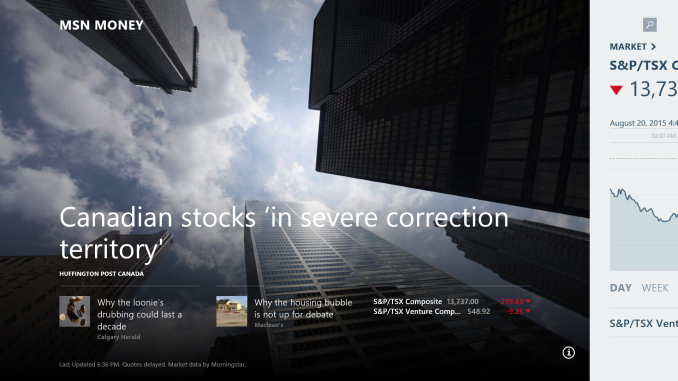 Windows 8 Design Language - Horizontal Scroll, App Bar, Charms - Money App Pictured
Windows 8 Design Language - Horizontal Scroll, App Bar, Charms - Money App Pictured
And of course what is an app store if there are no apps in it? Microsoft has certainly struggled to gain developer support for many big name apps, and even apps that were there like Twitter were not kept up to date, and were missing key features that were available on iOS and Android. It is too early to say if this will change with Windows 10, but there have already been some key apps released with the new Windows 10 design language, including Twitter.
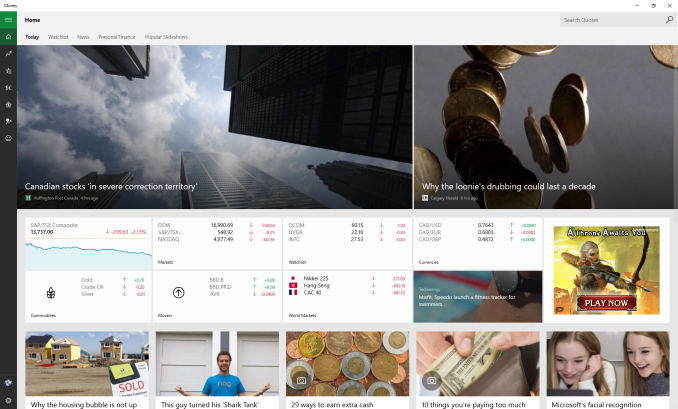 Windows 10 Design Language - Veritcal Scroll, Menu Bar on left with flyout, more information per page
Windows 10 Design Language - Veritcal Scroll, Menu Bar on left with flyout, more information per page
At Microsoft’s developer conference, they announced some big pieces to the puzzle too. Windows 10 will have support for iOS apps running as native code. This will still involve the developer having to import the apps and do a bit of coding, but the amount of work necessary to port an iOS app to Windows 10 is far less.
Android apps will also be able to be ported to Windows, but only on mobile devices like phones. This strategy makes a lot of sense, since iOS tends to have better tablet app support.
Porting apps from other operating systems is not a long term solution to the problem of lack of apps, but it is a short term solution which will at least drop the barrier to entry for devs that write on non-Windows platforms. The long term goal is to expand the footprint of Windows 10 enough so that it is a platform that developers want to target, but getting there is going to take some time. Microsoft’s goal is to have Windows 10 on a billion devices within three years of release. It’s an ambitious goal, but certainly one that is attainable for the Redmond based company.
Another change to the store which is coming later on in Windows 10’s life is that traditional desktop apps will be available through the store. This is a nice change and should make it a lot easier to purchase, install, and update these apps.
There will also be built in support for volume license customers to provide apps to their employees, and to offer a curated store to provide just what they require.
The store will also be the update mechanism for apps, as it is now, but also for system apps like the new browser named Edge, and other system features too can be updated through the store. It should offer faster updates, especially on mobile devices where system updates can get tied up by mobile operators.
Microsoft needs the store to be successful. Windows 10 brings about a lot of changes to help draw back customers, with the start menu, and other changes, but really the store is the key to everything. If they can’t bring developers in to the platform through the store, it is going to be tough for the rest of their strategy to come to fruition.


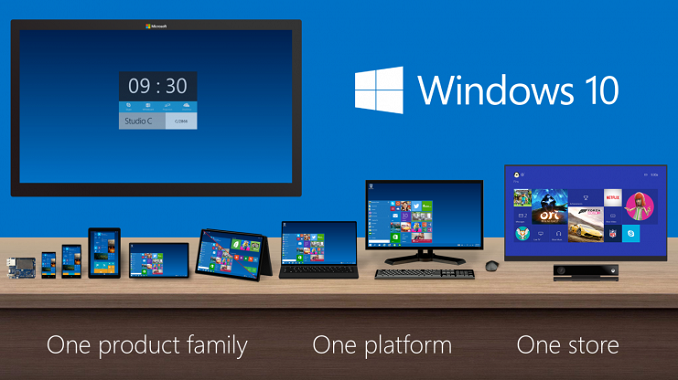

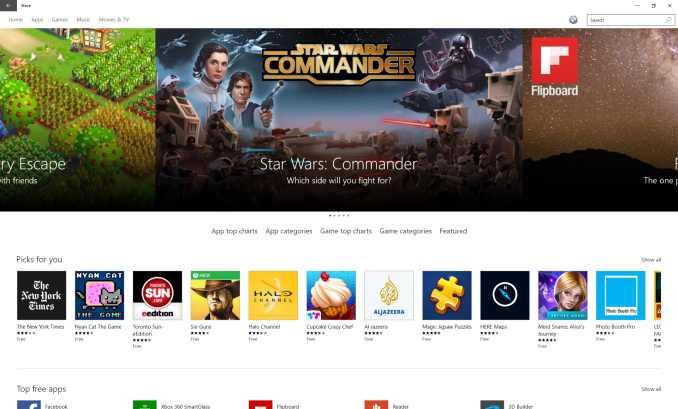
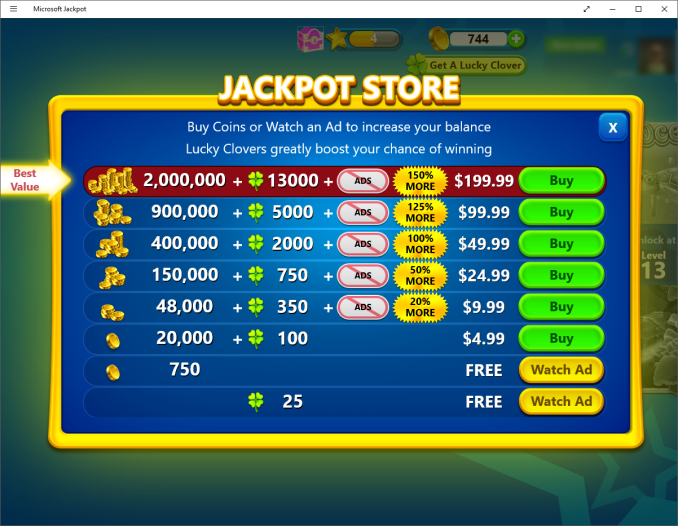
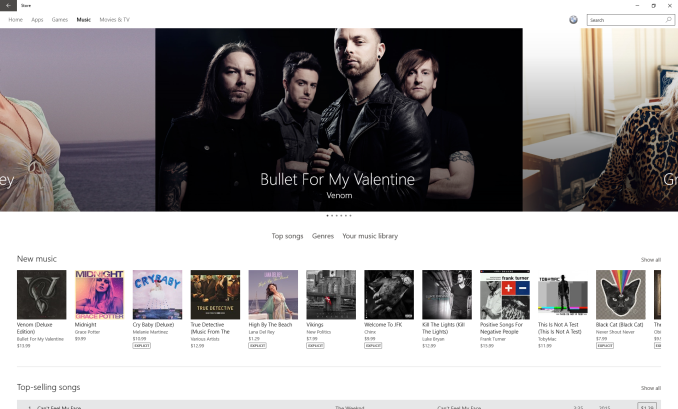








293 Comments
View All Comments
Brett Howse - Wednesday, August 26, 2015 - link
Page 4 on Continuum. Overall it's a slight step back on touch.marvdmartian - Wednesday, August 26, 2015 - link
[from the last page of the article] "But is this going to be the upgrade to move people off of Windows 7? In my opinion, yes it is."Perhaps in your world. Not so much, in mine. Nor, in many people I've talked to, who are equally unimpressed with this latest version of Windows.
In fact, so far, what I've seen (though, I admit, not yet experienced) of W10, I'd label it more of a Windows 8.2.....maybe 8.25. Still blocky looking. Still looks like the icons were drawn by a 3rd grader (no offense to the average 8 year old). Still.....just plain UGLY.
I understand the reasoning for the postage stamp sized blocks, as it makes touch interface much easier. But if they want TRUE switch-ability between touch interface and mouse/keyboard usage, they need to change the look of things, to go with the 2nd choice. Then there's also the return to the 90's screen resolution. Necessary for touch interface, perhaps. But when a person has spent hundreds of dollars on a high resolution monitor, then "upgrades" to Windows 10 (8.25?), they do NOT want to have to dial back their resolution to that which was supported first by what? Windows 98??
And don't even get me started in on the privacy issues. Yes, some people might not have a problem with the information Microsoft is gathering. But I'm betting plenty more will, once they're made aware of it. And for MS to force you to opt OUT of information gathering, makes them somewhat "big brother"-ish, in my book.
Sorry, Brett, but in my book, Microsoft is quickly striking out with this operating system. As far as their support of Windows 7, don't be surprised if they don't extend it, just as they did with Windows XP, if the majority of 7 users don't bother upgrading to 10.
chrome_slinky - Wednesday, August 26, 2015 - link
Unfortunately, for people who think, we must realize that the average user IS stupid, and FREE is making them weak in the knees.I will be on Windows 7 until 2020 at least, and carefully removed the "updates" which install more telemetry from my list of updates.
BTW, you could always use the "illudium235 space modulator" to take care of things, couldn't you? <g>
uhuznaa - Wednesday, August 26, 2015 - link
I'm sick of repeating this over and over but you really shouldn't confuse "is not interested in how computers work" with "stupid". I've seen people who are really bright in their fields totally struggling with their computers because they're just not interested in nor care for how these things work.It's like calling you "stupid" because you are not interested in knitting your own sweaters. I bet there are thousands of things you don't care for and are not interested in which others who are not necessarily smarter than you are really good in.
On the other hand not understanding this may be reason enough to call you stupid.
Michael Bay - Wednesday, August 26, 2015 - link
So, it`s you and your two and a half friends. Such tremendous loss for MS, certainly, somewhere in some basement Nadella is crying crocodile tears.Da W - Wednesday, August 26, 2015 - link
I moved from the FRENCH version of windows 7 to the FRENCH version of windows 8 to the FRENCH update of windows 8.1, somehow it installed the ENGLISH version of windows 10.chrome_slinky - Wednesday, August 26, 2015 - link
Zut alors!Billy_Boy - Wednesday, August 26, 2015 - link
The most thorough, well thought out review of ANY product I have read in a long, long time.Bravo!
milkod2001 - Wednesday, August 26, 2015 - link
I gave it a try and got w10 installed on top of my w7. All took about 30 minutes. All applications/games are working which is great. But that got me thinking what is WINDOWS 10?It feels just like windows 7.1 upgrade. New graphic interface, better boot time and slightly faster copy of files. OK lets not forget dx12 and Cortana. It took MS 6 years since release of w7 to put together this massive update and call it w10. Now i get why MS gave it to us for FREE. It just could not dare to charge us for bunch of mediocre updates.
Happy w10 user here :)
azazel1024 - Wednesday, August 26, 2015 - link
Can I just say, if you are coming from Windows 7, Windows 10 is a fairly nice upgrade. If you are coming from Windows 8.1, especially if you have a touch interface, it is a serious reversion in almost every possible way. Most of the apps seems half finished at best. As eluded to in the story, the mail client is about 10 steps back from the one in 8.1. How basic is it to have the ability to change from conversation view? Photos app doesn't support the ability to view images by folder (which can be nice instead of seeing every single one of your pictures spread out by date). Edge can't download some file types, so you have to open them in IE11. If you want to change audio volume, there is no option to do that in the action center (plenty of room for a button for it). So for a tablet, you have to pull up the task bar to do it, which doesn't make sense. Want to change a wifi network? Oh, there is a button in the action center to do...oh, it only turns Wifi on and off...but, wait, there is an airplane mode button also in there to do that. Oh, you can long press on the wifi button, then go in to settings and then select a different wifi network. Want to change the brightness to anything other than 25/50/75/100%, long press again and go in to settings and then you can adjust it from 0-100% in 1% increments. But...why can't there at least be a 0% brightness on that short cut button? 25% is too bright in a dark room. WHY!Sooooooo much of Windows 10 from what I have seen is "why in the hell would you do it that way?" Sure, some stuff in 8.1 was non-intuitive and took awhile to get used to, but a lot of stuff was a quick gesture and done. Want to change the brightness or audio? Swipe in the charms bar, hit the button and adjust away. Now they are found in different places and one of them takes several extra actions to really be able to adjust where you want it. Many of the apps have lost functionality, even if they look a little nicer or have a few new and nice features. I love that Edge is faster, but it sucks for touch input now and a lot of features have been lost that were highly useful, even with keyboard and mouse input.
Windows 10 at best feels half finished as an operating system. I don't mean "they'll innovate the 'OS as a Service that is Windows 10'". I mean, they needed to have spent at least a few more months baking this thing before sending it out the door and if a lot of this stuff isn't "changed" or give the user the ability to customize (why not add more options that you can add to the action center? What about allowing the user to ELIMINATE options in the action center too, I don't need half the crap that is in there as a short cut) then frankly Win 10 is a big step backward in a lot of ways.
I am willing to give it a try for awhile, but I am itching every single day to reload Windows 8.1 on my Asus T100. I am certainly not going to load Windows 10 on any of my other machines for a very long time to come (either right before the 1 year upgrade period ends, or possibly never).